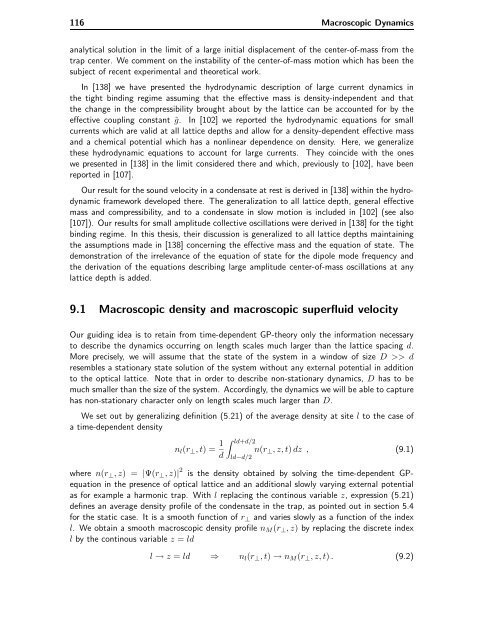Bose-Einstein Condensates in Rotating Traps and Optical ... - BEC
Bose-Einstein Condensates in Rotating Traps and Optical ... - BEC
Bose-Einstein Condensates in Rotating Traps and Optical ... - BEC
You also want an ePaper? Increase the reach of your titles
YUMPU automatically turns print PDFs into web optimized ePapers that Google loves.
116 Macroscopic Dynamics<br />
analytical solution <strong>in</strong> the limit of a large <strong>in</strong>itial displacement of the center-of-mass from the<br />
trap center. We comment on the <strong>in</strong>stability of the center-of-mass motion which has been the<br />
subject of recent experimental <strong>and</strong> theoretical work.<br />
In [138] we have presented the hydrodynamic description of large current dynamics <strong>in</strong><br />
the tight b<strong>in</strong>d<strong>in</strong>g regime assum<strong>in</strong>g that the effective mass is density-<strong>in</strong>dependent <strong>and</strong> that<br />
the change <strong>in</strong> the compressibility brought about by the lattice can be accounted for by the<br />
effective coupl<strong>in</strong>g constant ˜g. In [102] we reported the hydrodynamic equations for small<br />
currents which are valid at all lattice depths <strong>and</strong> allow for a density-dependent effective mass<br />
<strong>and</strong> a chemical potential which has a nonl<strong>in</strong>ear dependence on density. Here, we generalize<br />
these hydrodynamic equations to account for large currents. They co<strong>in</strong>cide with the ones<br />
we presented <strong>in</strong> [138] <strong>in</strong> the limit considered there <strong>and</strong> which, previously to [102], have been<br />
reported <strong>in</strong> [107].<br />
Our result for the sound velocity <strong>in</strong> a condensate at rest is derived <strong>in</strong> [138] with<strong>in</strong> the hydrodynamic<br />
framework developed there. The generalization to all lattice depth, general effective<br />
mass <strong>and</strong> compressibility, <strong>and</strong> to a condensate <strong>in</strong> slow motion is <strong>in</strong>cluded <strong>in</strong> [102] (see also<br />
[107]). Our results for small amplitude collective oscillations were derived <strong>in</strong> [138] for the tight<br />
b<strong>in</strong>d<strong>in</strong>g regime. In this thesis, their discussion is generalized to all lattice depths ma<strong>in</strong>ta<strong>in</strong><strong>in</strong>g<br />
the assumptions made <strong>in</strong> [138] concern<strong>in</strong>g the effective mass <strong>and</strong> the equation of state. The<br />
demonstration of the irrelevance of the equation of state for the dipole mode frequency <strong>and</strong><br />
the derivation of the equations describ<strong>in</strong>g large amplitude center-of-mass oscillations at any<br />
lattice depth is added.<br />
9.1 Macroscopic density <strong>and</strong> macroscopic superfluid velocity<br />
Our guid<strong>in</strong>g idea is to reta<strong>in</strong> from time-dependent GP-theory only the <strong>in</strong>formation necessary<br />
to describe the dynamics occurr<strong>in</strong>g on length scales much larger than the lattice spac<strong>in</strong>g d.<br />
More precisely, we will assume that the state of the system <strong>in</strong> a w<strong>in</strong>dow of size D>>d<br />
resembles a stationary state solution of the system without any external potential <strong>in</strong> addition<br />
to the optical lattice. Note that <strong>in</strong> order to describe non-stationary dynamics, D has to be<br />
much smaller than the size of the system. Accord<strong>in</strong>gly, the dynamics we will be able to capture<br />
has non-stationary character only on length scales much larger than D.<br />
We set out by generaliz<strong>in</strong>g def<strong>in</strong>ition (5.21) of the average density at site l to the case of<br />
a time-dependent density<br />
nl(r⊥,t)= 1<br />
ld+d/2<br />
n(r⊥,z,t) dz , (9.1)<br />
d ld−d/2<br />
where n(r⊥,z) = |Ψ(r⊥,z)| 2 is the density obta<strong>in</strong>ed by solv<strong>in</strong>g the time-dependent GPequation<br />
<strong>in</strong> the presence of optical lattice <strong>and</strong> an additional slowly vary<strong>in</strong>g external potential<br />
as for example a harmonic trap. With l replac<strong>in</strong>g the cont<strong>in</strong>ous variable z, expression (5.21)<br />
def<strong>in</strong>es an average density profile of the condensate <strong>in</strong> the trap, as po<strong>in</strong>ted out <strong>in</strong> section 5.4<br />
for the static case. It is a smooth function of r⊥ <strong>and</strong> varies slowly as a function of the <strong>in</strong>dex<br />
l. We obta<strong>in</strong> a smooth macroscopic density profile nM(r⊥,z) by replac<strong>in</strong>g the discrete <strong>in</strong>dex<br />
l by the cont<strong>in</strong>ous variable z = ld<br />
l → z = ld ⇒ nl(r⊥,t) → nM(r⊥,z,t) . (9.2)




